Number System Conversion Solved Examples Class 10 Computer Science
1. Decimal to Binary Number System Conversion
To convert decimal number to binary number follows the following steps:
a. Divide the given decimal number by 2 and write down the remainder.
b. Divide quotient by 2 and again write down the remainder.
c. Repeat the process until the quotient becomes zero.
d. Write the remainders from bottom to top.
Examples
2. Binary to Decimal Number System Conversion
To convert binary number to decimal number follows the following steps:
 |
3. Decimal to Octal number system conversion
To convert decimal number to octal number follows the following steps:
a. Divide the given decimal number by 8 and write down the remainder.
b. Divide quotient by 8 and write down the remainder.
c. Repeat the process until the quotient becomes zero.
d. Write the remainders from bottom to top.
5. Decimal to Hexadecimal Number System Conversion
To convert decimal number to hexadecimal number follows the following steps:
a. Divide the given decimal number by 16 and write down the remainder.
b. Divide quotient by 16 and write down the remainder.
c. Repeat the process until quotient becomes zero.
d. Write the remainders from bottom to top.
7. Binary to Octal Number System Conversion
To convert binary number to octal number follows the following steps:
a. Arrange binary digits in group of three from right to left.
b. Write respective octal number for each binary group.
c. Give the result base 8.
Examples:
i. (110010011)2 = (?)8
3 digits combination = 110 010 011
Octal Equivalent = 6 2 3
(110010011)2 = (623)8
Rough
4 2 1 4 2 1 4 2 1 ( Positive Powers of 2)
1 1 0 0 1 0 0 1 1
4 + 2 2 2 + 1 (Adding the numbers for 1)
6 2 3
ii. (100010011000)2 = (?)8
3 digits combination = 100 010 011 000
Octal Equivalent = 4 2 3 0
(100010011000)2 = (4230)8
Rough
4 2 1 4 2 1 4 2 1 4 2 1 (Positive Powers of 2)
1 0 0 0 1 0 0 1 1 0 0 0
4 2 2+1 0 ( Adding the numbers for 1)
4 2 3 0
8. Octal to Binary Number System Conversion
To convert octal number to binary number follows the following steps:
a. Write the octal digits separately.
b. Write binary triple equivalent to each octal number.
c. Give the result base 2.
Examples:
i. (236)8 = (?)2
Octal number = 2 3 6
Binary equivalent = 010 011 110
(236)8 = (010011110)2
Rough
2 3 6 (Octal Numbers
4 2 1 4 2 1 4 2 1
0 1 0 0 1 1 1 1 0 (3 bits equivalent Binary number) It is the sum of the digits that requires to bring the octal number of the question) For example: 6 = 4+2+0 (Added numbers are 1 and remaining 0)
ii. (704)8 = (?)2
Octal number = 7 0 4
Binary equivalent = 111 000 100
(704)8 = (111000100)2
Rough
7 0 4
4 2 1 4 2 1 4 2 1
1 1 1 0 0 0 1 0 0 (3 bits equivalent Binary number) It is the sum of the digits that requires to bring the octal number of the question) For example: 4 = 4+0+0 (Added numbers are 1 and remaining 0)
9. Binary to Hexadecimal number system conversion
To convert binary number to hexadecimal number follows the following steps:
a. Arrange binary digits in group of four from right to left.
b. Write respective hexadecimal number for each binary group.
c. Give the result base 16.
Examples:
i. (110010011)2 = (?)16
4 digits combination = 0001 | 1001 | 0011 |
Hexadecimal equivalent = 1 (110010011)2 = (193)16 Rough 8 4 2 1 8 4 2 1 8 4 2 1 0 0 0 0 1 1 0 0 1 0 0 1 1 1 8+1 2+1 1 9 3 ii. (10001001100)2 = (?)16 | 9 | 3 |
4 digits combination = 0100 | 0100 | 1100 |
Hexadecimal equivalent= 4 (110010011)2 = (193)16 Rough 8 4 2 1 8 4 2 1 8 4 2 1 0 1 0 0 0 1 0 0 1 1 0 0 4 4 8+4 1 9 12=C | 4 | C |
10. Hexadecimal to Binary number system conversion
To convert hexadecimal number to binary number follows the following steps:
a. Write binary equivalent 4 digits’ group to each hexadecimal number.
b. Give the result base 2.
Examples:
i. (9A3)16 = (?)2
4 digits combination = | 0100 | 0100 | 1100 |
Hexadecimal number = | 9 | A | 3 |
Binary equivalent = (9A3)16 = (100110100011)2
Rough | 1001 | 1010 | 0011 |
8 4 2 1 8 4 2 1 | 8 4 2 1 | ||
9 A=10 | 3 | ||
8 4 2 1 8 4 2 1 | 8 4 2 1 | ||
1 0 0 1 1 0 1 0 ii. (B0D)16 = (?)2 | 0 0 1 1 | ||
Hexadecimal number = | B | 0 | D |
Binary equivalent = (B0D)16 = (101100001101)2 Rough | 1011 | 0000 | 1101 |
B=11 0 | D=13 | ||
8 4 2 1 8 4 2 1 | 8 4 2 1 | ||
1 0 1 1 0 0 0 0 | 1 1 0 1 | ||
11. Octal to Hexadecimal number system conversion
To convert octal number to hexadecimal number follows the following steps:
a. Write binary triple equivalent to each octal number
b. Now, again form the group of four digits from right to left.
c. Write respective hexadecimal number for each binary group.
d. Give the result base 16.
Examples:
i. (236)8 = (?)16
Octal number = | 2 | 3 | 6 |
Binary equivalent = | 010 | 011 | 110 |
4 digits binary = | 1 0 01 | 1 1 1 0 | |
Hexadecimal equivalent= | 9 | E |
(236)8 = (9E)16
12. Hexadecimal to Octal number system conversion
To convert hexadecimal number to octal number follows the following steps:
a. Write binary equivalent 4 digits group to each hexadecimal number.
b. Now, again form the group of three digits from right to left.
c. Give the result base 8.
Examples:
i. (9A3)16 = (?)8
Hexadecimal = 9 A 3
Binary equivalent = 1001 1010 0011
3 digits binary = 100 110 100 011
Octal equivalent = 4 6 4 3
(9A3)16 = (4643)8
Binary Calculation
Generally, there are four types of binary calculation. They are:
1. Binary Addition,
2. Binary Subtraction,
3. Binary Multiplication
4. Binary Division.
1. Binary Addition
Binary addition is similar to decimal numbers addition. Some rules for adding binary numbers are:
0 + 0 = 0
0 + 1 = 1
1 + 0 = 1
1 + 1 = 10 (Write '0' here, carry 1 to next column)
Example:
1 0 1 0
+ 1 1 0 1
![]()
1 0 1 1 1
Hence, 1010 + 1101 = 1 0 1 1 1.
2. Binary Subtraction
Binary subtraction is similar to decimal number subtraction. Some rules for subtracting binary numbers are:
0 - 0 = 0
1 - 0 = 1
1 - 1 = 0
0 - 1 = 1 (with borrow 1 from the left column)
Example
1 0 1 1 1
- 1 0 1
![]()
1 0 0 1 0
Hence, 10 111 – 101 = 1 0 0 1 0.
3. Binary Multiplication
Binary multiplication is similar to decimal number multiplication. Some rules for multiplying binary numbers are:
0×0=0
1×0=0
0×1=0
1×1=1
Example 1 0 0[1]
× 1 0 1
![]()
10 0 1
0 0 0 0
1 0 0 1
![]()
1 0 1 1 0 1
Hence 1001 ×101 = 101101
Binary Division
Binary division is similar to decimal number division. Some rules for dividing binary numbers are:
0 ÷ 0 = 0
0 ÷ 1 = 0
1 ÷ 1 = 1
1 ÷ 0 = undefined
Example
ii. Divide 100101 by 110
Soln:
110)100101(110
-110
110
-110
X 1
- 0
1
:. Q= 110 R= 1
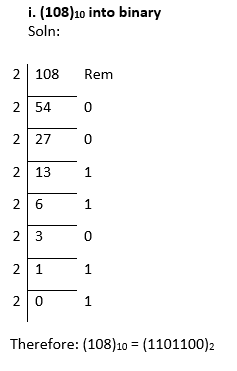
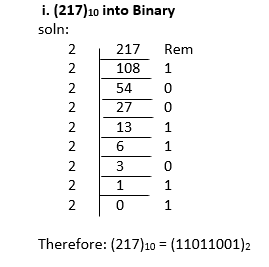
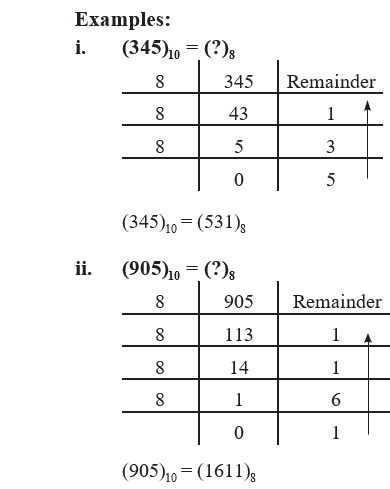
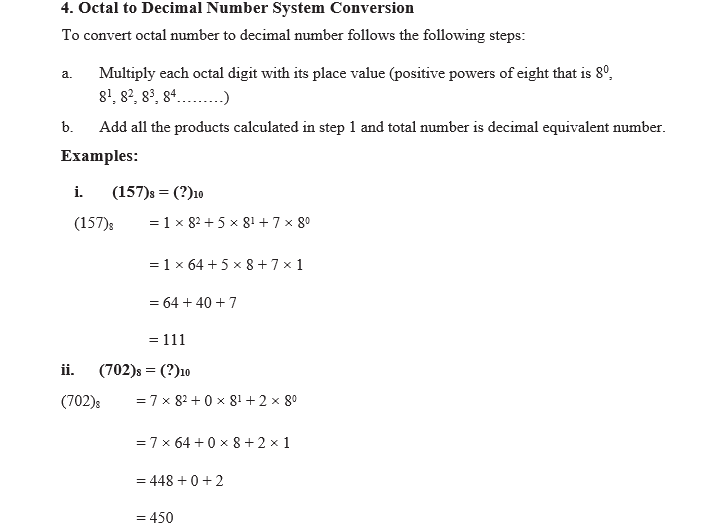

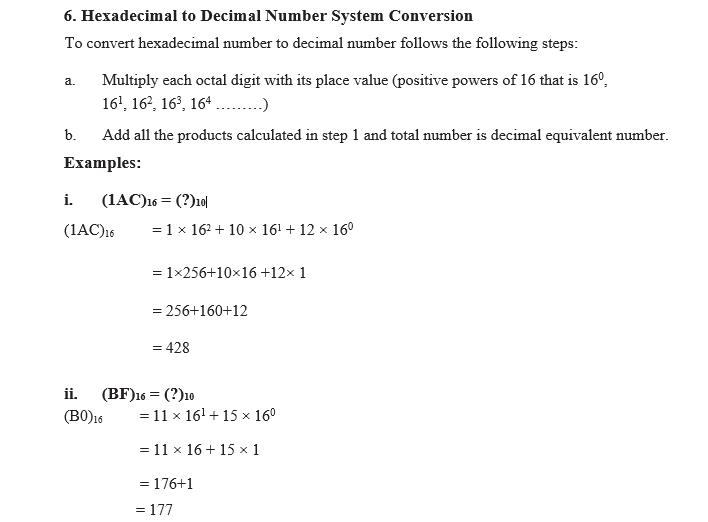
Comments
Post a Comment